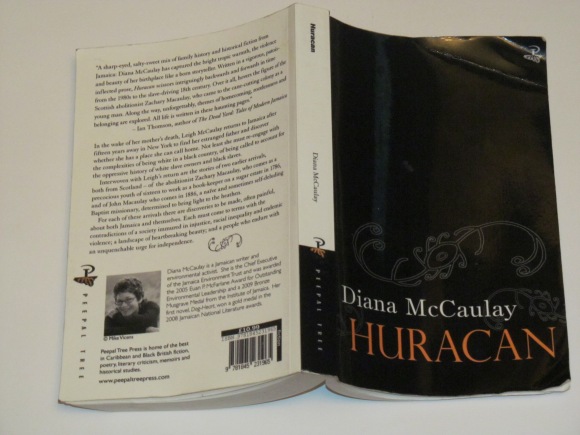 Huracan is an ambitious work by Diana McCaulay inspired by stories of her own family, that unfolds in Jamaica in three different time periods, the twentieth, nineteenth and eighteenth centuries.
Huracan is an ambitious work by Diana McCaulay inspired by stories of her own family, that unfolds in Jamaica in three different time periods, the twentieth, nineteenth and eighteenth centuries.
In some ways, Huracan is very different from McCaulay’s debut “Dog-Heart” which was set entirely in contemporary Jamaica, but one senses in both novels the author’s deep interest in exploring issues relating to class and colour. Huracan is a fascinating vehicle for that exploration, providing as it does, a showcase for close examination of class and colour prejudice in Jamaica over the centuries and the abuse of power generally at the expense of poor, black Jamaicans constituting the majority of the population.
The book opens with Leigh McCaulay, a white Jamaican, returning to the island after her mother’s death to be immediately greeted by the inevitable “White gal!” a description which forms the backdrop of her re-discovery of Jamaica of the 1980s, which she remembers from the privileged childhood vantage point of the small, closed circles inhabited by rich white Jamaicans. Her choice, this time, to live and work in an entirely different socio-cultural environment is all too obviously, just that, a choice which she can leave behind her at will, in contrast to the people around her.

Then there is the world of 1786, where slavery is still legal, and where Zachary Macaulay has arrived from Scotland to make something of himself, as a bookkeeper on a sugar plantation. The setting then shifts to
1885 post-Emancipation Jamaica where Pastor John Macaulay has just arrived from Scotland with dreams of ministering to his black flock.
The descriptions of life in Jamaica are vividly drawn with occasional tongue in cheek observations of contemporary Jamaica in particular – note the depiction of the household worker who comes to work and changes into a blue uniform with an apron and spends the day cooking, cleaning and serving but is not to be called a “maid,” nomenclature which became politically incorrect in post-Independence Jamaica, and the portraits of deliberately unhelpful service providers, as well as the exaggerated bonhomie of tourist workers trying to earn their share of the mighty US dollar.
One scene I found particularly interesting was that describing the passage of a hurricane on the slave plantation. While the hurricane lashes the Great House, the black house slaves:
“stood like sentries. Everyone else sat on chairs or on the floor…animals and machinery had been stored in the hurricane house but there had not been enough room for the over four hundred slaves of Bonnie Valley and many had faced the storm unsheltered.”
One can only imagine the thoughts and feelings of those house slaves knowing their families and friends were facing the hurricane in flimsy huts, and finding their bodies in the mud after the storm.
Ultimately this is a story about exploration – of self, of society and of country. McCaulay has created a cast of believable characters in three compelling stories which leave you wondering why Jamaica hasn’t progressed further and faster.
A very good read – highly recommended.








Recent Comments